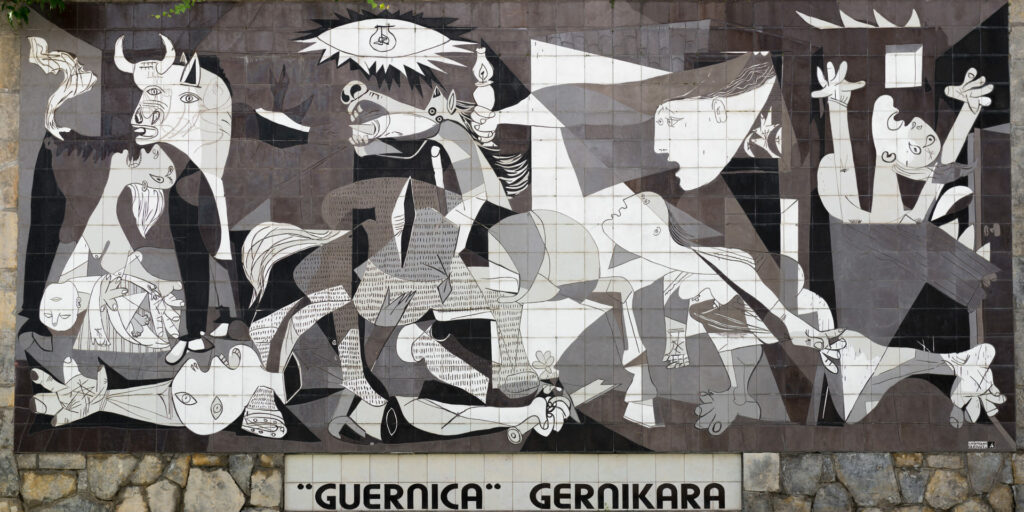
If you’re a lover of abstract art, Cubism or Surrealism, then you are in luck…2023 is the fiftieth anniversary of death of abstract artist Pablo Picasso…arguably the most influential and interesting abstract artist of all time.
To commemorate his death in 1973, throughout this year, there are currently 42 exhibitions being staged around the world dedicated to honouring his original artworks. Although he spent much of his adult life in France, Picasso originated from Spain (Malaga, Andalucia) and so naturally his work is being celebrated in his home land, including Malaga (his home town), Barcelona and Madrid.
At the vanguard of modern art
It could be said that Picasso was the first superstar of modern art. Famed for his weird and wonderful paintings, Picasso’s style is abstract and eye-catching. However, he was much more than a painter, he also sculpted, worked in print, ceramics and designed theatre sets and left a legacy of around 20,000 works of art.
No other artist in the 20th century was as well-known, feted, celebrated or more influential, due to his extraordinary ability to switch between different styles and mediums. Alongside George Braque, Picasso founded the avant-garde art movement Cubism, which described the practice of breaking the subject into pieces and rearranging out of sequence to create an abstract artwork. Picasso’s work and the movement, revolutionised European art, which resonated through music, literature and architecture.
Picasso’s style of abstract artwork
Possibly the closest we can come to describing his unique style, is that he paints what he thinks, not what he sees. It said to be difficult to pin down the exactly influences of Picasso’s work or indeed his overarching vision. This is because he was influenced by so many factors. For example, Guernica depicts the tortured faces of the Basque people who were being bombed.
The seemingly disparate styles of abstract art Picasso explored throughout his long life (80 years) provide a timeline not only for the tumultuous events happening in Europe, but also convey his love life, interests and state of mind. The effect of new loves and fatherhood, grief, loneliness and his response to the horrors of the wars are all evident in his works.
Picasso’s changing style
If you are unfamiliar with the Picasso’s work and styles, here is a summary of the different periods that defined his life and career. Full details are provided by the world-famous art auctioneer Christies.com which is also commemorating the painter’s life’s work.
- 1901-1904: The Blue Period
Picasso explained that he thought in blue and therefore started painting in blue after the suicide of his friend Carles Casagemas. - 1904-1906: The Rose Period
The Rose Period was start of a new poetic life in the bohemian enclave of Montmartre in Paris. - 1907 – 1914: Cubism
Started by Picasso and Georges Braques, the painting, “Les Demoiselles d’Avignon” was the first of its kind. - 1917-1925: Neoclassicism
During the First World War, Picasso shifted towards a more classical and ordered style influenced by classic Italian statues and his ballerina wife Olga Khokhlova. - 1930-1930: Surrealism
A turbulent time in his personal and professional life resulting in some of the most disjointed and surreal depictions of the female body. - 1935-1945: The War
Picasso lived in Paris throughout the war working on portraits, still life and sculptures, deliberately steering away from documenting the war. - 1946-1962: The Post-War years
New relationships and fatherhood led to a new softness in his work. He also formed bonds with impressionist artists, like Manet, after the death of his friend Matisse. - 1963-1973: Late Paintings
The 1960s saw a new style, new themes and a new dedication to his art, whilst immersing himself in literature which heavily influenced his work.
Abstract art at Studio 2
Studio 2 Art & Design’s studio in Puerto Banús, also in Malaga province, may not have the great man Picasso on hand, but there is a talented team of in-house abstract artists who can produce original bespoke artworks specific to your taste and requirements.
Studio 2’s very own abstract artist, Emily Portsmouth, has lived in Spain for over 25 years and is passionate about all aspects of abstract art. So, it is no surprise that she is great fan of Picasso’s extensive catalogue of work and is familiar with his styles of brush work, colours and subject matter. Which means that if you fancy commissioning original bespoke artwork that is reminiscent to the style of Picasso -no problem!
If you would like to commission a piece of custom artwork or to view the paintings and decorative items currently available for sale at Studio 2, visit the website. Alternatively, visit our workshop in Puerto Banús or contact us on welcome@studio2artdesign.com.
